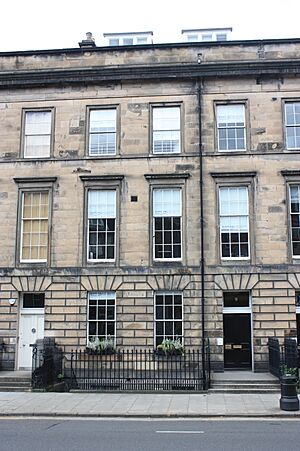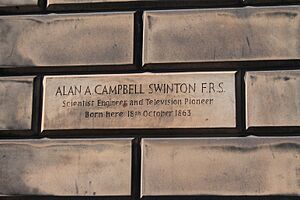Alan Archibald Campbell-Swinton facts for kids
Quick facts for kids
Alan Archibald Campbell-Swinton
|
|
|---|---|

Alan Campbell-Swinton
|
|
| Born | 18 October 1863 Albyn Place, Edinburgh, Scotland
|
| Died | 19 February 1930 (aged 66) |
| Nationality | British |
| Education | Fettes College, Edinburgh |
| Occupation | Electrical engineer |
| Known for | The first man to provide the theoretical basis for a completely electronic television system |
| Notes | |
|
Elected a Fellow of the Royal Society in 1915
|
|
Alan Archibald Campbell-Swinton (born October 18, 1863 – died February 19, 1930) was a Scottish electrical engineer. He is famous for coming up with the main ideas for electronic television. He thought of how it could work about 20 years before the technology was ready.
Around 1903, Campbell-Swinton started trying out cathode ray tubes. These special vacuum tubes use electron beams to create images. He wanted to use them to send and receive pictures electronically.
In 1908, he wrote a letter to the science magazine Nature. In this letter, he explained his ideas for a fully electronic television system. His idea was key to how cathode ray tube televisions worked. He suggested changing the cathode ray tube so it could both send and receive light.
His ideas became the foundation for electronic television. Later inventors used his concepts to build the first working cathode ray tube televisions. These TVs became the standard for many decades. Many people believe Campbell-Swinton deserves credit for first imagining how to use a cathode ray tube for imaging.
Contents
Life and Early Discoveries
Alan Campbell-Swinton was born in Edinburgh, Scotland. His father was Archibald Campbell Swinton, a lawyer.
He went to school at Cargilfield Trinity School and Fettes College from 1878 to 1881.
Campbell-Swinton was one of the first people to explore using radiography in medicine. Radiography uses X-rays to see inside the body. In 1896, he opened the first X-ray lab in the United Kingdom. He also discovered something called magnetic focusing in 1896. He found that a magnet could focus an electron beam.
In 1915, he was chosen as a Fellow of the Royal Society. This is a very high honor for scientists.
How He Imagined Electronic Television
In 1908, Campbell-Swinton read an article in Nature by Shelford Bidwell. The article was about "Telegraphic Photography and Electric Vision." Even back then, people knew that older "mechanical" ways of making TV pictures had problems. These problems included flickering images and poor picture quality.
Campbell-Swinton wrote his own letter to Nature, which was published on June 18, 1908. It was titled "Distant Electric Vision." He explained his idea for electronic television. He wrote that the problem could be solved by using two beams of cathode rays. One beam would be at the sending station and one at the receiving station.
These beams would sweep across a surface very quickly. This would happen so fast that our eyes would see a continuous picture. At the receiving end, the moving electron beam would hit a special screen that glows. By changing the strength of the beam, it would create the desired picture.
In 1911, Campbell-Swinton gave a speech in London. He explained in great detail how "distant electric vision" could work. He suggested using cathode ray tubes (CRTs) for both sending and receiving pictures. For the sending device, he imagined a screen made of tiny rubidium cubes that could detect light. This was the very first idea for electronic television, which is still used today.
At the time, other inventors were already trying to use cathode ray tubes to receive pictures. But Campbell-Swinton was the first to suggest using them to send pictures. His idea for a fully electronic television system became well-known. Hugo Gernsback, a popular science writer, called it the "Campbell-Swinton Electronic Scanning System" in 1915.
Campbell-Swinton continued to describe his system. He spoke about it in 1914 and published a book about it in 1921. In 1928, he wrote in Modern Wireless magazine: "Surely it would be better policy if those who can afford the time and money would abandon mechanical devices and expend their labours in what appears likely to prove the ultimately more promising method in which the only moving parts are imponderable electrons."
This quote shows he believed electronic methods were much better than mechanical ones for television.
Later Experiments and Legacy
In 1926, Campbell-Swinton also shared results from some experiments he did with G. M. Minchin and J. C. M. Stanton. They tried to create an electrical signal by shining an image onto a metal plate coated with selenium. A cathode ray beam then scanned this plate.
These early experiments were not very successful. However, they were repeated later in 1937 by other scientists. These new experiments showed that Campbell-Swinton's original idea had potential. They found that better images could be made by using different coatings on the metal plate. These experiments laid the groundwork for the future vidicon, a type of video camera tube.
Besides his work on images, Campbell-Swinton also worked on voice telephones. He even started a telephone company called the Equitable Telephone Association in the 1880s.
See also



